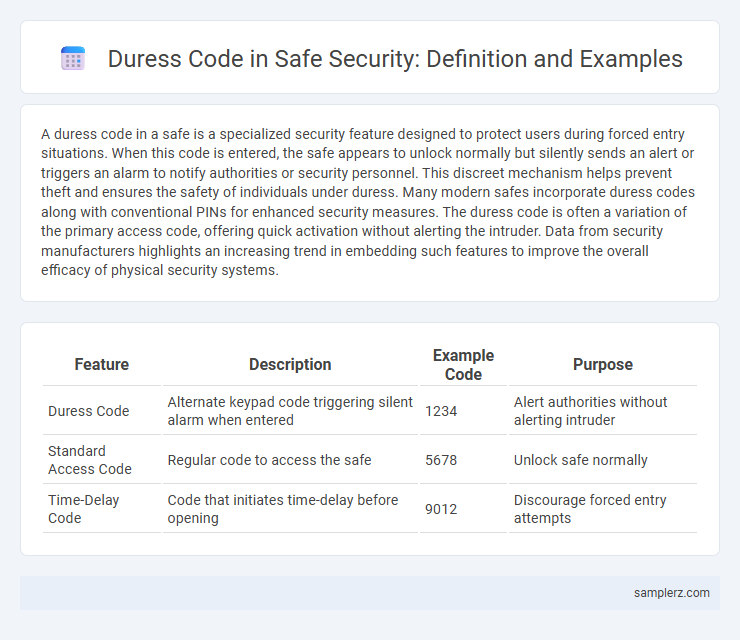A duress code in a safe is a specialized security feature designed to protect users during forced entry situations. When this code is entered, the safe appears to unlock normally but silently sends an alert or triggers an alarm to notify authorities or security personnel. This discreet mechanism helps prevent theft and ensures the safety of individuals under duress. Many modern safes incorporate duress codes along with conventional PINs for enhanced security measures. The duress code is often a variation of the primary access code, offering quick activation without alerting the intruder. Data from security manufacturers highlights an increasing trend in embedding such features to improve the overall efficacy of physical security systems.
Table of Comparison
| Feature | Description | Example Code | Purpose |
|---|---|---|---|
| Duress Code | Alternate keypad code triggering silent alarm when entered | 1234 | Alert authorities without alerting intruder |
| Standard Access Code | Regular code to access the safe | 5678 | Unlock safe normally |
| Time-Delay Code | Code that initiates time-delay before opening | 9012 | Discourage forced entry attempts |
Understanding Duress Codes in Security Systems
Duress codes in security systems act as covert signals entered during an emergency to silently trigger alarms without alerting an intruder. These codes are often variations of regular access codes, designed to grant apparent access while notifying security personnel or law enforcement of duress situations. Understanding and implementing duress codes enhances safety protocols by providing discreet panic alert mechanisms within safes and access control systems.
The Purpose of Duress Codes for Safes
Duress codes in safes are secret numeric sequences designed to silently trigger an alarm or alert authorities without alerting an intruder. Their primary purpose is to enhance security by allowing individuals to comply with demands while secretly signaling distress. This mechanism increases the chances of a timely response and helps prevent theft or harm during forced entry situations.
Common Examples of Duress Codes Used in Safes
Common examples of duress codes used in safes include entering a specific alternate PIN that appears to unlock the safe but silently triggers an alarm or notifies security personnel of a forced access attempt. These codes are often simple variations of the primary PIN, such as adding or subtracting a digit, or reversing the sequence. Security systems integrate duress codes to enhance response protocols during potential coercion or robbery scenarios.
How Duress Codes Differ from Regular Safe Codes
Duress codes in safes are specially programmed sequences that appear to grant access but silently trigger an alarm or notify authorities when used under coercion. Unlike regular safe codes that simply unlock the safe, duress codes enhance security by providing a covert distress signal without alerting the perpetrator. This dual-function mechanism ensures both access control and emergency response in high-risk situations.
Real-World Scenarios Involving Duress Codes
Duress codes in safes are critical security features that allow users to discreetly signal distress during a forced entry or coercion scenario. For instance, a bank manager confronted by armed robbers might enter a duress code, triggering a silent alarm while appearing to open the safe normally. Real-world applications include home safes used by VIPs who, under threat, input a secondary code that grants limited access and alerts security services without escalating the danger.
Best Practices for Setting Up Duress Codes
Setting up duress codes for safes involves assigning discreet, easy-to-remember numeric sequences that trigger silent alarms during forced access attempts. Best practices emphasize selecting codes distinct from regular access codes and ensuring they are confidentially communicated to trusted personnel only. Regularly updating duress codes and integrating them with alarm monitoring systems enhances security and response effectiveness during duress situations.
Integrating Duress Codes with Alarm Monitoring
Integrating duress codes with alarm monitoring systems allows users to silently signal distress while disarming a safe, triggering an immediate alert to security personnel without raising suspicion. This seamless connection enhances security protocols by enabling real-time response to coercion scenarios, minimizing the risk of forced entry or theft. Alarm monitoring providers often customize duress code functionality to ensure reliable activation and swift dispatch of emergency services upon detection.
Legal and Ethical Considerations for Duress Codes
Duress codes in safes serve as covert signals triggering silent alarms during forced access, raising significant legal and ethical considerations regarding user consent and privacy. Ensuring clear policies around the use of duress codes minimizes liability and aligns with regulations such as GDPR and HIPAA, which protect personal information and require transparent security practices. Companies must balance effective emergency response with respect for individual rights to avoid misuse and potential legal repercussions.
Case Studies of Duress Code Effects in Security Events
Duress codes, such as silently triggering alarms during forced safe access, have proven crucial in thwarting robberies and kidnappings, as seen in the 2018 bank heist in Miami where staff discreetly activated the duress code to alert authorities without escalating the threat. Case studies reveal that integrating duress codes with real-time monitoring systems significantly reduces response time, minimizing harm and increasing the likelihood of suspect capture. Security protocols incorporating duress codes demonstrate marked improvements in crisis outcomes by enabling covert communication during high-risk security breaches.
Future Trends: Advancements in Duress Code Technology
Future trends in duress code technology emphasize integrating biometric authentication with dynamic duress codes to enhance security for safes. Advanced AI-driven systems predict suspicious behavior patterns, enabling real-time alerts and automatic lockdown protocols. The incorporation of blockchain technology ensures tamper-proof audit trails for all duress code activations, significantly improving forensic analysis and response times.

example of duress code in safe Infographic
 samplerz.com
samplerz.com